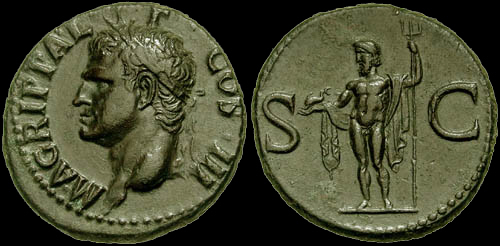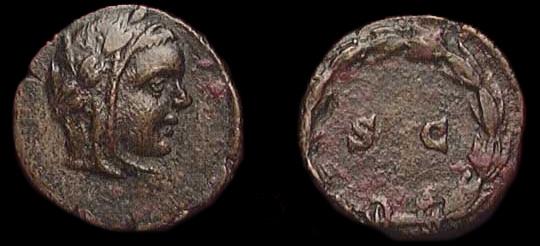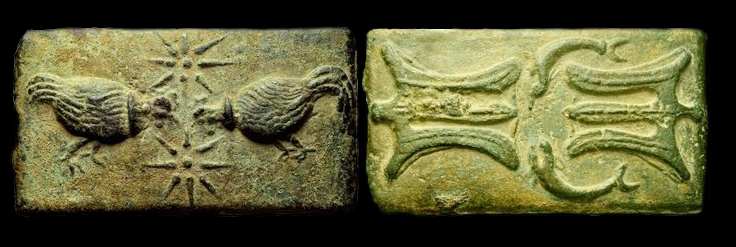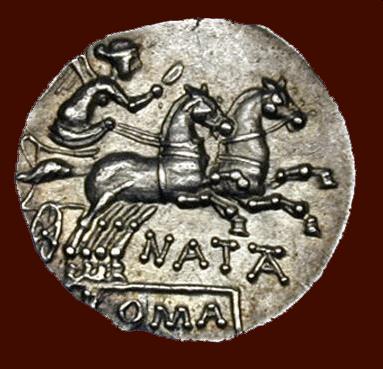








Designed by Nigel G Wilcox

Everything For The Metal Detectorist - Denominations





The Paragon Of Metal Detecting
& Archaeology
& Archaeology
Powered By Sispro1
Roman Currency - Numismatics (Coins)
Denominations from Augustus until the End of the 3rd Century A.D:
In Copper / Bronze


Quadrans = quarter as ca. 1.7 cm, ca. 3 gr
Please note that not all denominations were in use throughout the full period.
Also there was a tendency of inflation that reduced both the size and the content of precious metal over the centuries. E.g. late Antoniniani towards the end of the third century AD contain hardly any silver and often look like bronze coins.
Along this line the lower denominations like the quadrans and the semis became obsolete along the way, while the double pieces like Antoninianus or Double Sestertius were introduced only in the third century.
The weights and sizes given are average values only.
Please note that not all denominations were in use throughout the full period.
Also there was a tendency of inflation that reduced both the size and the content of precious metal over the centuries. E.g. late Antoniniani towards the end of the third century AD contain hardly any silver and often look like bronze coins.
Along this line the lower denominations like the quadrans and the semis became obsolete along the way, while the double pieces like Antoninianus or Double Sestertius were introduced only in the third century.
The weights and sizes given are average values only.
Roman Timeline

Roman Menu
Copyright All Rights Reserved by Nigel G Wilcox E-Mail: ngwilcox100@gmail.com
As ca. 2.6-3.0 cm, ca. 10-12 gr
A Rare and Exceptional Roman Republican Ingot, Among the Finest Known
Ingot circa 280-260, Æ 1461 g. Two chickens feeding and facing each other; in centre field, above and below chickens’ heads, an eight rayed star. Rev. Two tridents pointing inwards; between them, two dolphins snout to snout. Haeberlin pl 53, 1. Thurlow-Vecchi AS 24, pl. 23. Crawford 12/1.
Extremely rare and among the finest of very few specimens known. An impressive issue with an untouched green patina, extremely fine
Ex Sternberg 18, 1986, 275 and Triton I, 1997, 754 sales. From the Goodman collection.
The early Italic monetary system was based on the value of bronze, rather than silver or gold, which had long been preferred in the Greek world, including in the colonies founded by the Greeks in southern Italy and Sicily. The earliest bronze money was what Pliny the Elder called aes rude, lumps that were cast or broken into irregular shapes. While it fulfilled the need to condense value, it traded by weight, and thus was missing one of the key elements of coinage, a unit of value that was part of a well-structured system. Over time this principal objection was mitigated as bronze began to be cast into meaningful shapes, in this case rectangular bars or ingots which seem to be what Pliny calls aes signatum. A further refinement occurred when designs, and even inscriptions were incorporated into their manufacture. By the time this aes signatum was cast the Romans and their central Italian neighbours had established something much closer to a coinage system than would have been recognised only decades before. This particular example is complete and represents an important relic of the Roman monetary system. Its neatly symmetrical design shows on its obverse two feeding hens flanked by stars, and the reverse presents confronted dolphins between trident-heads (or rostra, as Thomsen describes them). When it was necessary to make change, the bars were broken. The fact that most known examples of aes signatum are incomplete bars suggests this was a fairly common practice. What followed was an even greater refinement, as the rectangular bars of the aes signatum were transformed into bronzes cast in a disc shape, the aes grave. These coins incorporated marks of value in the designs and copied the round shape of coins that the Greeks had long been producing in the Italian peninsula. Intermingling with these cast lumps, ingots and circular discs of bronze were struck silver coins that the Romans either commissioned or made themselves sporadically from the late 4th Century through to the late 3rd Century. It is now generally accepted that the first Roman silver coins, the Mars/horse-head didrachms, (Cr. 13/1), are from the late 4th Century rather than the traditionally suggested period of c.290/80-275. Evidence from several realms suggest these first didrachms helped fund cooperative efforts between Romans and Campanians (with Neapolis as the probable mint) against the Samnites in about 326 B.C., at the start of the Second Samnite War. It is possible, however, that the occasion was the First Samnite War (343-341), especially since the only passage in which Livy describes Roman silver coinage (rather than bronze) in this early period is in his report of Rome’s peace with the Campanians in 340 (VIII.11.16).
Ingot circa 280-260, Æ 1461 g. Two chickens feeding and facing each other; in centre field, above and below chickens’ heads, an eight rayed star. Rev. Two tridents pointing inwards; between them, two dolphins snout to snout. Haeberlin pl 53, 1. Thurlow-Vecchi AS 24, pl. 23. Crawford 12/1.
Extremely rare and among the finest of very few specimens known. An impressive issue with an untouched green patina, extremely fine
Ex Sternberg 18, 1986, 275 and Triton I, 1997, 754 sales. From the Goodman collection.
The early Italic monetary system was based on the value of bronze, rather than silver or gold, which had long been preferred in the Greek world, including in the colonies founded by the Greeks in southern Italy and Sicily. The earliest bronze money was what Pliny the Elder called aes rude, lumps that were cast or broken into irregular shapes. While it fulfilled the need to condense value, it traded by weight, and thus was missing one of the key elements of coinage, a unit of value that was part of a well-structured system. Over time this principal objection was mitigated as bronze began to be cast into meaningful shapes, in this case rectangular bars or ingots which seem to be what Pliny calls aes signatum. A further refinement occurred when designs, and even inscriptions were incorporated into their manufacture. By the time this aes signatum was cast the Romans and their central Italian neighbours had established something much closer to a coinage system than would have been recognised only decades before. This particular example is complete and represents an important relic of the Roman monetary system. Its neatly symmetrical design shows on its obverse two feeding hens flanked by stars, and the reverse presents confronted dolphins between trident-heads (or rostra, as Thomsen describes them). When it was necessary to make change, the bars were broken. The fact that most known examples of aes signatum are incomplete bars suggests this was a fairly common practice. What followed was an even greater refinement, as the rectangular bars of the aes signatum were transformed into bronzes cast in a disc shape, the aes grave. These coins incorporated marks of value in the designs and copied the round shape of coins that the Greeks had long been producing in the Italian peninsula. Intermingling with these cast lumps, ingots and circular discs of bronze were struck silver coins that the Romans either commissioned or made themselves sporadically from the late 4th Century through to the late 3rd Century. It is now generally accepted that the first Roman silver coins, the Mars/horse-head didrachms, (Cr. 13/1), are from the late 4th Century rather than the traditionally suggested period of c.290/80-275. Evidence from several realms suggest these first didrachms helped fund cooperative efforts between Romans and Campanians (with Neapolis as the probable mint) against the Samnites in about 326 B.C., at the start of the Second Samnite War. It is possible, however, that the occasion was the First Samnite War (343-341), especially since the only passage in which Livy describes Roman silver coinage (rather than bronze) in this early period is in his report of Rome’s peace with the Campanians in 340 (VIII.11.16).

Copper - Bronze
Augustus Until End of 3rd Century
Gold
Silver
Brass
Copper Bronze
Roman Currency
6. Menu
Pages
Main Coin Menu
Roman Coin Menu
Member NCMD
























